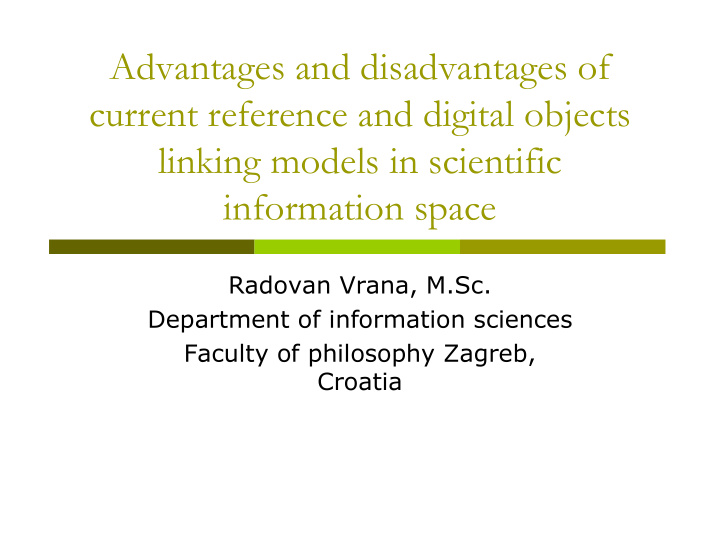



Advantages and disadvantages of current reference and digital objects linking models in scientific information space Radovan Vrana, M.Sc. Department of information sciences Faculty of philosophy Zagreb, Croatia
Introduction � Growth of electronic information resources � Almost 50% percent of online resources not directly accessible � Global instruments for the direct access to information resources necessary 2
Deconstruction of information resources � 1990s - deconstruction of larger information chunks into smaller information objects � Development of a learned article as a mechanism for the systematic publication of fragments of scientific knowledge (Ziman) � Scientists: integrators of fragmented knowledge 3
Requirements (Lynch) � Referencing � Linking � Archiving � Global interlinked virtual library (Harnad) 4
Early information systems � Static links pre-computed and built into a linking database � Links to local or locally licensed content bases + information about library holdings � Advantage: � Access the full text of the cited work by searching the database � Disadvantage: � Alteration in database was a tedious job 5
PURLs � Special kind of URL � Points to an address (URL) resolver server/service � Resolver service stores the information where PURL points to � Appropriate copy problem � Changes: users are redirected to a new URL � PURL offers an URL which is permanent 6
7
The OpenURL � Context-sensitive linking among resources based on the metadata embedded in OpenURLs � Encoding parts of citations as an URL � Transporting metadata about information object � Two parts of OpenURL: � BASEURL � QUERY 8
OpenURL - structure � BASEURL identifies the OpenURL resolver - provides context sensitive services for the OpenURL � QUERY contains one or more DESCRIPTIONs. � Each DESCRIPTION contains the metadata attributes and values that make up the citation for the resource 9
Example � http://demo.exlibrisgroup.com:9003http://sfxserver.uni.ed u/sfxmenu?genre=article&id=doi:10%2E1045%2Fapril2003 lavoie&atitle=Trends%20in%20the%20Evolution%20of%20 the%20Public%20Web &title=D-Lib%20Magazine&stitle=D- Lib%20Mag&issn=1082-9873&date=2003-04- 15&volume=9&issue=4&aulast=O%27Neill&aufirst=Edwar &auinit=T%2E 10
11
Appropriate copy problem � Appropriate copy – finding information + its location(s) � Location information depending on user context (electronic res. subscriptions, doc. delivery system etc.) � Digital libraries: user profiles, context sensitive environment 12
OpenURL � Advantages: � User context � Multiple document locations � Follows standard URL syntax � Accreditation for standard � Disadvantages: � Not widely accepted � Still complex to implement (what if there is no resolver nearby?) � Who should take care of the resolver? Libraries? 13
CrossRef � CrossRef – based on DOI � DOI not yet common in citations on the Internet � DOI related to publishers, and not libraries � DOI server – centralized approach � Shorter than OpenURL � follows standard URL syntax � OpenURL can contain DOI as an attribute = CrossRef can be part of OpenURL enabled architecture 14
15
Croatia � Croatian scientific bibliography � Local copy of information object � Voluntary upload of metadata and documents � No place for URLs � Good starting point for mechanisms like OpenURL or CrossRef 16
Conclusion � OpenURL like systems – feasible � Using the existing Internet standards � Libraries still not acquainted with possible benefits � Such mechanisms necessary because of the versatile technology on the Internet 17
Recommend
More recommend